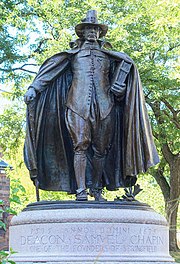
Back محاكمات السحر في سالم Arabic محاكمات السحر فى سالم ARZ Salem cadugər məhkəmələri Azerbaijani Судовы працэс над салемскімі ведзьмамі Byelorussian Процес на вещиците от Салем Bulgarian সালেম ডাইনী বিচারাবলি Bengali/Bangla Judici a les Bruixes de Salem Catalan Salemský čarodějnický případ Czech Hekseprocesserne i Salem Danish Hexenprozesse von Salem German

| Part of a series on |
| Puritans |
|---|
 |
The Salem witch trials were a series of hearings and prosecutions of people accused of witchcraft in colonial Massachusetts between February 1692 and May 1693. More than 200 people were accused. Thirty people were found guilty, nineteen of whom were executed by hanging (fourteen women and five men). One other man, Giles Corey, died under torture after refusing to enter a plea, and at least five people died in the disease-ridden jails.[1]
Arrests were made in numerous towns beyond Salem Village (known today as Danvers) and its regional center Salem Town, notably in Andover and Topsfield. The grand juries and trials for this capital crime were conducted by a Court of Oyer and Terminer in 1692 and by a Superior Court of Judicature in 1693, both held in Salem Town, where the hangings also took place. It was the deadliest witch hunt in the history of colonial North America. Fourteen other women and two men were executed in Massachusetts and Connecticut during the 17th century.[2] The Salem witch trials only came to an end when serious doubts began to arise among leading clergymen about the validity of the spectral evidence that had been used to justify so many of the convictions, and due to the sheer number of those accused, "including several prominent citizens of the colony".[3]
In the years after the trials, "several of the accusers – mostly teen-age girls – admitted that they had fabricated their charges."[3] In 1702, "the General Court of Massachusetts declared the trials unlawful",[4] and in 1711 the Massachusetts legislature annulled the convictions, passing a bill "mentioning 22 individuals by name"[4] and reversing their attainders.
The episode is one of colonial America's most notorious cases of mass hysteria. It was not unique, but a colonial manifestation of the much broader phenomenon of witch trials in the early modern period, which took the lives of tens of thousands in Europe. In America, Salem's events have been used in political rhetoric and popular literature as a vivid cautionary tale about the dangers of isolation, religious extremism, false accusations, and lapses in due process.[5] Many historians consider the lasting effects of the trials to have been highly influential in the history of the United States. According to historian George Lincoln Burr, "the Salem witchcraft was the rock on which the [New England] theocracy shattered."[6]
At the 300th anniversary events held in 1992 to commemorate the victims of the trials, a park was dedicated in Salem and a memorial in Danvers. In 1957, an act passed by the Massachusetts legislature absolved six people,[7] while another one, passed in 2001, absolved five other victims.[8] As of 2004, there was still talk about exonerating or pardoning all of the victims.[9] In 2022, the last convicted Salem witch, Elizabeth Johnson Jr., was officially exonerated, 329 years after she had been found guilty.[4]
In January 2016, the University of Virginia announced its Gallows Hill Project team had determined the execution site in Salem, where the 19 "witches" had been hanged. The city dedicated the Proctor's Ledge Memorial to the victims there in 2017.[10][11]
- ^ Snyder, Heather. "Giles Corey". Salem Witch Trials. Archived from the original on November 22, 2019. Retrieved December 3, 2019.
- ^ Demos, John (1983). Entertaining Satan : Witchcraft and the Culture of Early New England. Oxford: Oxford University Press. pp. 11, 401–409. ISBN 9780195033786.
- ^ a b Vaughan, Alden (1997). The Puritan Tradition in America. UP of New England. p. 283. ISBN 978-0874518528. Archived from the original on September 19, 2023. Retrieved November 13, 2020.
- ^ a b c Katz, Brigit (August 3, 2022). "Last Convicted Salem 'Witch' Is Finally Cleared". Smithsonian Magazine. Retrieved October 12, 2024.
- ^ Adams 2008
- ^ Burr, George Lincoln, ed. (1914). Narratives of the Witchcraft Cases, 1648–1706. C. Scribner's Sons. p. 195n1.
- ^ "Six Victims of 1692 Salem Witch Trials 'Cleared' by Massachusetts..." December 2, 2015. Archived from the original on January 18, 2018. Retrieved January 17, 2018.
- ^ "Massachusetts Clears 5 From Salem Witch Trials". The New York Times. November 2, 2001. Archived from the original on January 30, 2018. Retrieved January 29, 2018.
- ^ "Salem may pardon accused witches of 1692". archive.boston.com. The Boston Globe. Archived from the original on January 17, 2018. Retrieved January 17, 2018.
- ^ Writer, Dustin Luca Staff (July 19, 2017). "On 325th anniversary, city dedicates Proctor's Ledge memorial to Salem Witch Trials victims". Salem News. Archived from the original on November 1, 2019. Retrieved November 1, 2019.
- ^ Caroline Newman, "X Marks the Spot" Archived April 29, 2016, at the Wayback Machine, UVA Today, 16 January 2016, accessed 28 April 2016